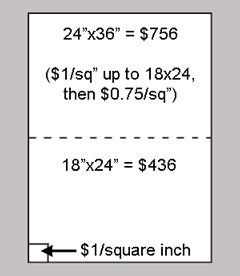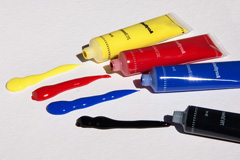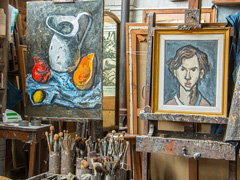| PRICING YOUR ARTWORK |
 |
|
One of the biggest struggles faced by artists who are just beginning to put their artwork up for sale is deciding how much they should charge for each piece. It's a balancing act between prices low enough that people are willing to buy, and prices so low you are no longer making the money you deserve for your hard work and talent.
This article considers various ideas and approaches to determining appropriate pricing for your original artwork that will result in sales and satisfied customers.
|
SUMMARY
| COMPARING YOUR WORK |
DETERMINING A PRICE |
OUTSIDE FACTORS |
INCREASING THE COST |
| Do your research. Compile a list of artists who create similar work and have similar artistic backgrounds, then use their art prices to help you judge the feasibility of your own. |
You can base your artwork prices on one of these factors, or a combination: Artwork Size; Necessary Materials; Labor/Hourly Wage |
What knowledgeable outsiders think your art is worth is something to taking into consideration. We'll also talk briefly about how galleries price work and what you should consider when selling to them. |
Finally, we'll discuss how and when you should raise the price of your artwork. Over time, you certainly deserve to make more money from your trade, but move too quickly and you'll lose ground. |
|
| COMPARISON PRICING
|
 |
|
Even though you're an artist first, in order to be a successful, self-sufficient artist, you need to become a bit of a business person, too.
One of the best ways to determine prices for your original artwork (and likewise your prints and other offerings), is to seek out other artists whose artistic history and artwork coincide in numerous ways with your own. You can be sure potential buyers will be contrasting and comparing works as they shop, so beat them to it.
Do a search for artists who are similar to you in the following ways:
- They have equivalent training: they're self-taught like you, have a Bachelor's degree like you, or have taken numerous evening classes, like you.
- They use the same or similar media you do: acrylic paint, oil paint, pencil, charcoal, clay, etc.
- They create pieces in the same or similar style to your work: abstract, representative, conceptual.
- They have artwork for sale in sizes similar to your own.
- They have had no solo shows, like you, or shows that received recognition similar to your own.
- They have only just recently begun selling their artwork.
Once you have developed a list of the artists who match your own artistic experience in numerous ways, you can use this information to develop your own prices. But copy and paste isn't always the best approach, either. If you decide your art should be priced between the $200 and $500 marks, you may want to start closer to that $200 level. There's a good chance you'll sell more because your art is some of the most affordable for people hunting in that price range. Even if they have $500 to spend, most customers would rather spend $200 if they have the choice.
Another reason to delve more deeply into the inner workings of your price point is to understand what factors determined those prices. This is important for your own justification, but also gives you the ability to explain and defend what you charge to any potential buyer who questions the price tag.
"Um, because it's really good" is not a good enough reason for charging $1000 dollars for a painting. Nor is "because that other artist with work like mine charges the same." You want to be prepared with a logical reason for your artwork prices, in case someone requests an explanation. We'll talk more about this in the next section.
|

Be realistic: determine your prices based on similar, living artists, not Vincent Van Gogh
|
| TANGIBLE PRICE FACTORS
|
 |
|
As mentioned above, once you have your list of comparable prices, you'll still want to figure out your own formula, if only to make sure you aren't bankrupting yourself by matching the existing market.
The following points outline the different factors used in determining art prices. We'll start with the ones you should avoid, and move on to those that are justifiable, and most likely used by the artists on your comparison list to set their own prices.
YOUR UNIQUE ARTWORK
It's easy to compare yourself to famous artists and decide your work is as good as theirs - or better - and therefore you should be able to sell your art for 10,000 or 100,000 dollars. In most cases, however, if you use the checklist above to compare yourself to these artists, you'll find you have little or nothing in common besides your own (and perhaps others') perception of quality.
Likewise, some artists determine their art is worth tens of thousands because it is perfectly unique, unlike anything else in the history of art. In his artbusiness.com article on pricing your artwork, art appraiser Alan Bamberger makes an excellent point: however unique you may think your style, however unique it may actually be, the professional (and amateur) art critics who look at it will always be able to compare it to something already out there, or categorize it in a genre that already exists.
There's nothing wrong with thinking your work is unique, but that can't be the only factor you use to determine its dollar value.
EMOTIONAL ATTACHMENT
Huge ranges in price can throw off a buyer, and even turn them away. Don't price one artwork for $3000, and the rest of it for a couple hundred just because you went through a breakup while you painted that one, or found your muse, or were inspired by the song which is now tattooed on your forearm.
Unless there are logical reasons for the wild price increase, make a choice: either sell that special piece for the same as the pieces of similar size or material, or don't sell it at all and keep it out of your showroom. Most buyers won't want to ask why that piece is so expensive (they don't want to look stupid in front of the artist), and even if they do ask, if your only response is "because my heart and soul went into that piece," it's unlikely you'll sell them on it. Only you can put a price on your own heart and soul.
FACTOR 1: SIZE
One good way to ensure your prices are uniform (to avoid that unexplained spike) is to figure out a base price per square inch (or even square foot, if you regularly create extremely large pieces).
You can set this using your comparison list, in fact. Figure out what those artists are charging per square inch of the artwork - you may even find many of them are within the same price bracket.
Once you've settled on, say, $1/square inch, you may want to determine a cap for that price. For example, you charge $1/square inch for artwork up to 18x24" ($432), then additional square inches are $0.75/square inch ($756 for a 24x36").
If you work solely with acrylics on cotton canvas, this is a perfectly acceptable method. However, if you use various media, you'll need to take other factors into consideration.
FACTOR 2: MATERIALS
The materials you use to create your art pieces should be factored into your per square inch price. If you can determine how many tubes of paint you use for one painting, that will serve as part of your price. Don't forget, if you sometimes use acrylics, and sometimes use oils with gold foil, you'll want two different prices because the latter materials are more costly than the former.
Paint is the most obvious material to factor in to you cost, but don't forget the myriad other tools and items you might use regularly:
- Canvas or paper
- Brushes (need to be replaced)
- Pencils and erasers
- Texture mediums or other mix-ins
- Hanging hardware
Though not technically materials, you'll also want to consider the other things that allow you to work on your art. If you rent a studio, you'll need to factor in a percentage of that cost. If you work from home, perhaps late into the night with strong lights, you can include part of your energy and heating bills. If any portion of your work is outsourced (acrylic mounts, laser cutting, etc.), that cost must also be considered.
FACTOR 3: LABOR
Whichever of the methods above you use to price your artwork, you also have to pay yourself an hourly rate. If you did your calculations accurately, the price taken from size or materials should allow you to break even on supplies, but you have yet to actually make a profit from your artwork. The time you spent creating that piece of art is worth something, just like the time you would spend at work as a salesperson would be worth something to your employer (who, in this case, is you).
You can set up an hourly rate based on how long it takes you to complete a painting, or you may choose to apply an additional 10-20% of the materials/size cost.
If you had professional training, paying that off (even if you don't have student loans) should be factored into the labor cost. You'll also want to consider any other time taken up for the artwork. Besides simply painting the finished piece, you may have spent time planning, sketching designs, researching, or holding meetings with those who commissioned your work.
Don't assume you're worth hundreds of dollars an hour, but don't sell yourself short, either. You have talent and ability, so you deserve to make a liveable hourly wage using these skills.
Once you have developed what you consider a fair price for your artwork, compare it to your list of similar artists. If your prices are considerably higher than theirs, you may need to reconsider your hourly wage (or double check to make sure you recorded those artstis' selling prices). If your numbers are considerably lower, perhaps you aren't paying yourself enough.
|

Price your artwork by size

Price your artwork by materials used

Price your artwork by hours of labor
|
| THE MARKET AND GALLERIES
|
 |
PRECEIVED WORTH
Most likely, every artist has a different idea in their mind of what "affordable" means, just like they have differing opinions on "top dollar." It's always a good idea to see what other, knowledgeable people think your art is worth, and compare that amount to your own numbers.
Also remember there's a difference between what family and friends will pay for your art, and what everyone else will. Just because your painting sold to your aunt for $1500 doesn't mean a stranger who cares more about furnishing their home than making sure you don't become a starving artist will be willing to pay $1500, or even $800.
Prices of art you've sold at charities are also skewed from reality. The recipient of that piece was likely paying toward the worthiness of the cause, rather than the quality of your art.
Another word about your variety of customers: don't disregard those who appreciate your work but can't afford to pay thousands, or even hundreds of dollars. Make small originals, high quality Giclée prints, even 5x7" cards depicting your artwork available to people on a more limited budget who want to support you. Those small sales can add up quickly.
GALLERIES
Let's talk briefly about selling your work in a gallery.
First of all, it should be noted that when making your comparison list, recording what a gallery sells an artist's work for is not ideal. A gallery is a business, and must therefore charge more than what the artist is making in order to make their own profit. Depending on the reputation of the gallery, they may advertise the art for as much as double what the artist will be paid for it.
This is the difference between gallery prices and wholesale prices. Wholesale is what the artist is paid for their art, and this is the amount you should be considering when planning your own pricing. Not only are you removing the middle man when you're selling your work directly, but you also don't provide the amenities the gallery can: comfortable seating, the perfect lighting and, most notably, the years of expertise and vast knowledge about art most gallery owns can offer their customers.
Another reason gallery prices are not a good reference is the false markup they sometimes employ. Just because a work hanging on their wall is being sold for $2000 doesn't mean they won't barter down to $1500, or $1000. Furthermore, some artists and galleries decide to price specific pieces very high, so the other artwork - priced at 1/3 of that price, or even less - seems more attractive and affordable to potential buyers. In this case, they rarely expect to ever sell the high priced piece - it's like a decoy.
SELLING THROUGH A GALLERY
A few things to keep in mind if a gallery offers to sell your work:
- You may not be allowed to sell work outside the gallery, or at least not wholesale out of your home. If someone can get your work for $1000 directly from you, they're unlikely to buy it for $1500 at the gallery.
- Remember your piece will be marked up. You may need to lower your wholesale prices so the markup price is not too high for your targeted buyers. Depending on the reputed success of the gallery, the relative guarantee that you'll be selling lots of pieces may eventually outweigh the pay cut you're taking.
- Accept that a gallery will be making money off your artwork, possibly as much as you are making yourself. Keep in mind the fact that your work is being sold at a gallery is great padding for your resume and gives you some bragging rights. Don't lock yourself into a lifelong contract, but don't refuse a gallery with a high markup based only on principle.
|


|
| RAISING PRICES
|
 |
|
Finally, after you've established the price points for your artwork, how do you go about raising the prices?
A couple of suggestions for beginning to make more from your work:
- Don't rush it. Wait until you've been selling work regularly for many months, or as long as a year. You should be seeing an increase in sales.
- Take it slow. Don't jack the price of your 8x10" paintings from $200 to $2000 overnight. Pros recommend a 10% rise in price to begin with. You can always consider going higher later, but if you go too high, you likely won't get those lost customers back.
- Keep it real. No matter what price you slap on your artwork, always make sure you can back up the reason. If someone wants to know why your new 8x10" piece costs 30% more than the one they bought three years ago, you should be able to tell them you have had three solo shows since then, you received your Master's of Fine Art, or similar works are currently hanging in six high profile private collections.
|

|
|
If you have questions about any of our services or products, don't hesitate to contact us. Our knowledgeable staff is always happy to assist with answers, advice, or suggestions.
Useful resource: How Any Artist Can Price Their Art for Sale, published on Artbusiness.com.
|
|
© 2002-2025 - KeenART Media Ltd.
|
|
| |
|

